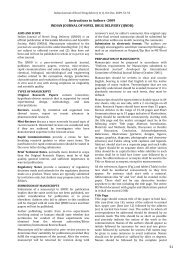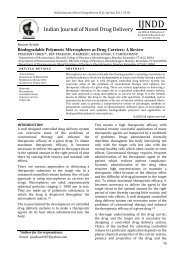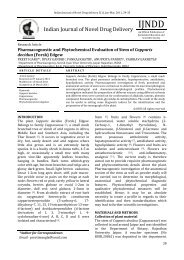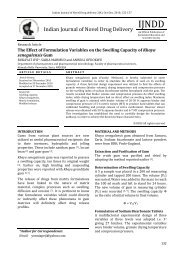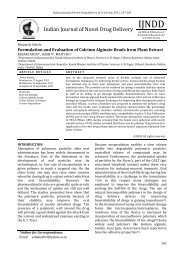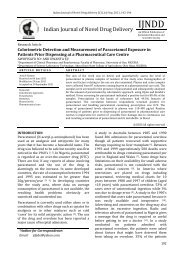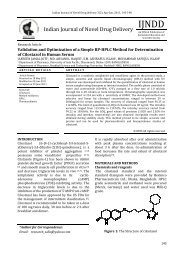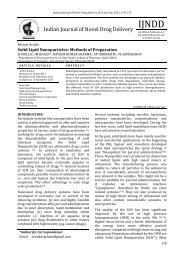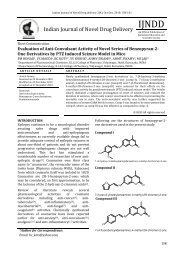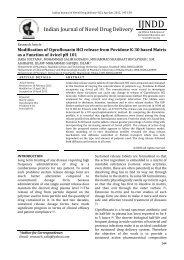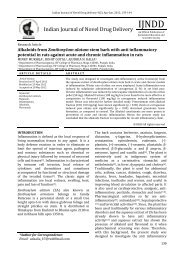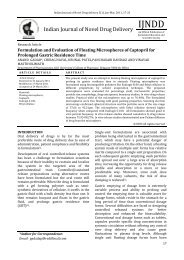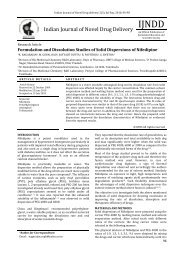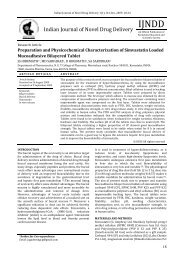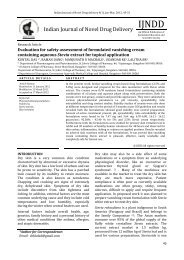Design and Development of Floating Tablet of Ranitidine ...
Design and Development of Floating Tablet of Ranitidine ...
Design and Development of Floating Tablet of Ranitidine ...
Create successful ePaper yourself
Turn your PDF publications into a flip-book with our unique Google optimized e-Paper software.
Natasha Sharma et al / Indian Journal <strong>of</strong> Novel Drug Delivery 3(4), Oct-Dec, 2011, 296-302<br />
hydrochloride is desirable. The short biological<br />
half-life <strong>of</strong> drug (~2.5-3 hours) also favors<br />
development <strong>of</strong> these formulation. A traditional<br />
oral sustained release formulation releases most<br />
<strong>of</strong> the drug at the colon, thus the drug should<br />
have absorption window either in the colon or<br />
throughout the gastrointestinal tract. <strong>Ranitidine</strong><br />
is absorbed only in the initial part <strong>of</strong> the small<br />
intestine <strong>and</strong> has 50% absolute bioavailability.<br />
Moreover, colonic metabolism <strong>of</strong> ranitidine is<br />
partly responsible for the poor bioavailability <strong>of</strong><br />
ranitidine from the colon. These properties <strong>of</strong><br />
ranitidine hydrochloride do not favor the<br />
traditional approach to sustained release<br />
delivery. Hence, clinically acceptable sustained<br />
release dosage forms <strong>of</strong> ranitidine hydrochloride<br />
prepared with conventional technology may not<br />
be successful [4]. The present investigation<br />
applied a systematic approach to formulate the<br />
floating tablet <strong>of</strong> ranitidine with various grades<br />
<strong>of</strong> polymer hydroxyl propyl methylcellulose<br />
(HPMC) in various combinations. The prepared<br />
tablets were evaluated for physical parameters<br />
such as shape, dimension, hardness, friability<br />
test, weight variation test, buoyancy / floating<br />
Test, swelling index <strong>and</strong> drug content. All the<br />
tablets were evaluated for In vitro drug release<br />
studies [5,6] .<br />
MATERIALS AND METHODS<br />
<strong>Ranitidine</strong> was obtained as gift sample (Ranbaxy<br />
Lab Ltd, Dewas, India). Other chemical <strong>and</strong><br />
polymers such as hydroxyl propyl<br />
methylcellulose (HPMC K4M, K15M, K100M,<br />
15CPS <strong>and</strong> 3 CPS) was obtained as gift sample<br />
from Ranbaxy Lab Ltd, Dewas, India). All other<br />
reagents <strong>and</strong> chemicals used were <strong>of</strong> analytical<br />
grade.<br />
Preparation <strong>of</strong> <strong>Floating</strong> <strong>Tablet</strong> <strong>of</strong> <strong>Ranitidine</strong><br />
Hydrochloride<br />
<strong>Floating</strong> tablets containing <strong>Ranitidine</strong><br />
Hydrochloride were prepared by wet granulation<br />
process using 2% PVP K-30 in Isopropyl alcohol<br />
as a binding agent using varying concentrations<br />
<strong>of</strong> different grades <strong>of</strong> polymers with Carbopol<br />
934, sodium bicarbonate, calcium bicarbonate<br />
<strong>and</strong> adipic acid. Polymers <strong>and</strong> effervescent<br />
mixtures were blended in pestle <strong>and</strong> motor, 2%<br />
PVP-K30 solution in isopropyl alcohol was used<br />
as binder to form a moist mass. Granules were<br />
obtained by passing through the sieve no 12 the<br />
granules were dried at 45 ºC for 1 hour in oven<br />
dried granules were again passed through the<br />
sieve no. 22 <strong>and</strong> granules obtained was<br />
compressed in a tablet by using single punch<br />
h<strong>and</strong> operating tablet compression machine.<br />
Compositions <strong>of</strong> various formulation batches are<br />
shown in Table 1.<br />
In vitro evaluation <strong>of</strong> floating tablets:<br />
Evaluation was performed to assess the<br />
physicochemical properties <strong>and</strong> release<br />
characteristics <strong>of</strong> the developed formulations.<br />
Pre-compression parameters:<br />
a) Angle <strong>of</strong> Repose (θ):<br />
The frictional forces in a loose powder or<br />
granules can be measured by angle <strong>of</strong> repose.<br />
This is the maximum angle possible between the<br />
surface <strong>of</strong> a pile <strong>of</strong> powder or granules <strong>and</strong> the<br />
horizontal plane.<br />
The granules were allowed to flow through the<br />
funnel fixed to a st<strong>and</strong> at definite height (h). The<br />
angle <strong>of</strong> repose was then calculated by<br />
measuring the height <strong>and</strong> radius <strong>of</strong> the heap <strong>of</strong><br />
granules formed.<br />
tan θ = h/r<br />
θ = tan -1 (h/r)<br />
Where, θ = angle <strong>of</strong> repose<br />
h = height <strong>of</strong> the heap<br />
r = radius <strong>of</strong> the heap<br />
b) Compressibility Index:<br />
The flow ability <strong>of</strong> powder can be evaluated by<br />
comparing the bulk density (ρ o) <strong>and</strong> tapped<br />
density (ρ t) <strong>of</strong> powder <strong>and</strong> the rate at which it<br />
packed down [7]. Compressibility index was<br />
calculated by –<br />
Compressibility index (%) = ρ t – ρ o x 100<br />
ρ t<br />
Where ρ o = Bulk density g/ml<br />
ρ t = Tapped density g/ml.<br />
Post compression parameters:<br />
Physical Parameters<br />
The tablets were evaluated for shape, hardness<br />
(Monsanto hardness tester), thickness using<br />
calibrated varniear caliper, friability using Roche<br />
friabilator <strong>and</strong> weight variation test.<br />
Drug Content<br />
Twenty tablet <strong>of</strong> each formulation were crushed<br />
to powdered in pestle <strong>and</strong> motor <strong>and</strong> power<br />
equivalent to 100 mg <strong>of</strong> drug was added in 100<br />
ml <strong>of</strong> 0.1 N HCL (pH 1.2). The resulting solution<br />
called the stock solution <strong>and</strong> filters the resulting<br />
solution through 0.45 μm membrane, diluted<br />
suitably <strong>and</strong> analyzed for drug content<br />
spectrophotometrically at 315 nm using 0.1 N<br />
HCL as a blank [8] .<br />
297



